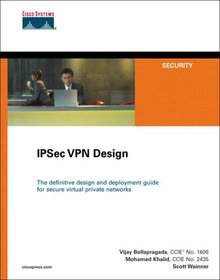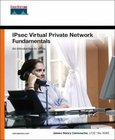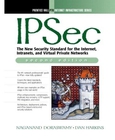IPSec VPN Design
2nd Edition

Book Details:
| Publisher: | Cisco Press |
| Series: | Cisco Press |
| Author: | Vijay Bollapragada |
| Edition: | 2 |
| ISBN-10: | 1587051117 |
| ISBN-13: | 9781587051111 |
| Pages: | 384 |
| Published: | Apr 08 2005 |
| Posted: | Nov 19 2014 |
| Language: | English |
| Book format: | CHM |
| Book size: | 8.87 MB |
Book Description:
The definitive design and deployment guide for secure virtual private networks Learn about IPSec protocols and Cisco IOS IPSec packet processing Understand the differences between IPSec tunnel mode and transport mode Evaluate the IPSec features that improve VPN scalability and fault tolerance, such as dead peer detection and control plane keepalives Overcome the challenges of working with NAT and PMTUD Explore IPSec remote-access features, including extended authentication, mode-configuration, and digital certificates Examine the pros and cons of various IPSec connection models such as native IPSec, GRE, and remote access Apply fault tolerance methods to IPSec VPN designs Employ mechanisms to alleviate the configuration complexity of a large- scale IPSec VPN, including Tunnel End-Point Discovery (TED) and Dynamic Multipoint VPNs (DMVPN) Add services to IPSec VPNs, including voice and multicast Understand how network-based VPNs operate and how to integrate IPSec VPNs with MPLS VPNs Among the many functions that networking technologies permit is the ability for organizations to easily and securely communicate with branch offices, mobile users, telecommuters, and business partners. Such connectivity is now vital to maintaining a competitive level of business productivity. Although several technologies exist that can enable interconnectivity among business sites, Internet-based virtual private networks (VPNs) have evolved as the most effective means to link corporate network resources to remote employees, offices, and mobile workers. VPNs provide productivity enhancements, efficient and convenient remote access to network resources, site-to-site connectivity, a high level of security, and tremendous cost savings. IPSec VPN Design is the first book to present a detailed examination of the design aspects of IPSec protocols that enable secure VPN communication. Divided into three parts, the book provides a solid understanding of design and architectural issues of large-scale, secure VPN solutions. Part I includes a comprehensive introduction to the general architecture of IPSec, including its protocols and Cisco IOS IPSec implementation details. Part II examines IPSec VPN design principles covering hub-and-spoke, full-mesh, and fault-tolerant designs. This part of the book also covers dynamic configuration models used to simplify IPSec VPN designs. Part III addresses design issues in adding services to an IPSec VPN such as voice and multicast. This part of the book also shows you how to effectively integrate IPSec VPNs with MPLS VPNs. IPSec VPN Design provides you with the field-tested design and configuration advice to help you deploy an effective and secure VPN solution in any environment. This security book is part of the Cisco Press Networking Technology Series. Security titles from Cisco Press help networking professionals secure critical data and resources, prevent and mitigate network attacks, and build end-to-end self-defending networks.
Download Link:
Related Books:
Demystifying the IPsec Puzzle
Now that the Internet has blossomed into the "Information Superhighway" with its traffic and drivers becoming increasingly diverse, security has emerged as a primary concern. This book offers the reader a global, integrated approach to providing internet security at the network layer. The author gives a detailed presentation of the revolutionary IPsec technology used today to create Virtual Private Networks and, in the near future, to protect the infrastructure of the Internet itself. The book addresses IPsec's major aspects and components to help the reader evaluate and compare features of different implementations. It provides a detailed understanding of this cutting-edge technology from the inside, which enables the reader to more effect...
IPSec Virtual Private Network Fundamentals
An introduction to designing and configuring Cisco IPsec VPNs Understand the basics of the IPsec protocol and learn implementation best practices Study up-to-date IPsec design, incorporating current Cisco innovations in the security and VPN marketplace Learn how to avoid common pitfalls related to IPsec deployment Reinforce theory with case studies, configuration examples showing how IPsec maps to real-world solutions IPsec Virtual Private Network Fundamentals provides a basic working knowledge of IPsec on various Cisco routing and switching platforms. It provides the foundation necessary to understand the different components of Cisco IPsec implementation and how it can be successfully implemented in a variety of network topologies and markets (...
IPSec
2nd Edition
IPSec, Second Edition is the most authoritative, comprehensive, accessible, and up-to-date guide to IPSec technology. Two leading authorities cover all facets of IPSec architecture, implementation, and deployment; review important technical advances since IPSec was first standardized; and present new case studies demonstrating end-to-end IPSec security. New coverage also includes in-depth guidance on policies, updates on IPSec enhancements for large-scale enterprise environments, and much more....
2007 - 2021 © eBooks-IT.org



